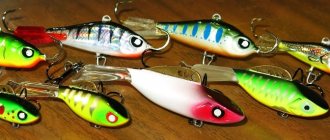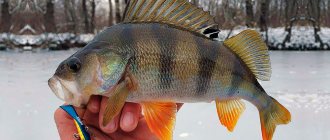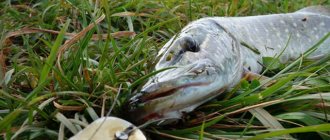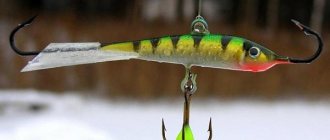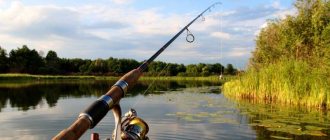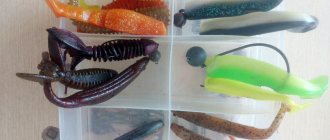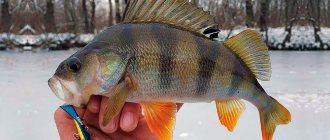Mebaru is the colloquial name for a fish of the scorpion fish family (Sebastes inermis) that inhabits the coasts of the Japanese islands. Its characteristic features are: a short body, a wide forehead, small hard scales and large black eyes.
Mebaru balancer
Today, the balancer is perhaps the most popular bait among anglers who practice vertical trolling. In its simplicity and versatility, it is superior to most vertical spinners, not to mention such specific gear as the “balda”, “snitch” or burbot jig. Another undoubted advantage of this bait is that there are practically no “elusive” balancer models. By purchasing even the cheapest and most unsightly bait with a bunch of flaws, you can be sure that after minor and simple modifications, it will be possible to correct it to a completely satisfactory condition.
However, the lures of some manufacturers stand out noticeably from others. For example, Finnish Rapala balancers, Korean Damiki and Japanese Izumi, which have become classics of winter fishing. Interesting working qualities are distinguished by some balancers of non-standard shapes:
- Russian RB (models “Balancer”, “Acrobat”),
- Japanese Jackall Bros (model “FYUN PYUN JIG”).
Perhaps, at present, it is Japanese companies that can lay claim to leadership in the production of the highest quality and technically sophisticated baits. In addition to the above-mentioned Izumi and Jackall Bros, there are others, among which the main interest is the Lucky John company. Balancers of this brand have enjoyed well-deserved popularity for many years, which is greatly facilitated by their wide range of shapes, sizes, colors, and good price-quality ratio. Classic models of Lucky John lures include CLASSIK, PLIANT, FIN, SOFT. Each of them is endowed with certain functional properties, which allows, with a very small set of balancers, to select a bait that ideally matches the fishing conditions that change during fishing.
The latest development from Lucky John is the Pro Series line of lures - a new generation of balancers called Mebaru. Available in 4 sizes (37,47,57 and 67 mm) and ten color options. But the main thing that distinguishes this bait is its unusual technical and hydrodynamic characteristics.
The compact body of the Mebaru balancer is more reminiscent of a classic wobbler than the usual narrow and slender body of the balancer. The similarity is enhanced by the characteristic arrangement of hanging hooks (in the absence of fixed front and rear ones). The wide frontal plane brings the bait closer to rattlins both in appearance and in some nuances of the game. Precise fit of all parts and high-strength paint coating provide the balancer with a long service life without significant signs of wear.
To form the right opinion about the bait, let’s look at it in more detail.

Mebaru balancers
Brand Attractiveness
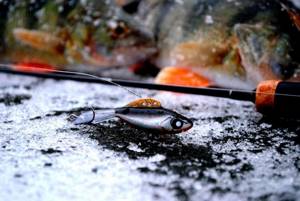
At first, this manufacturer specialized in the production of wobblers, then gradually moved on to balancers. This is probably why the balancers of this line are a bit like a wobbler, misleading novice fishermen.
The company was founded in the late 80s by a group of enthusiastic fishermen. They immediately set themselves the task of producing tackle of improved quality and catchability.
In 2012, the Lucky John company began producing silicone baits of the following types:
- twisters;
- vibrotails;
- wobblers;
- rings and clasps;
- and finally, balancers.
Quite quickly, Mebaru tackle gained steady popularity, which is explained by the following reasons:
- High-quality materials are used in the manufacture of these balancers;
- the tackle is characterized by increased strength;
- the design was developed taking into account the possible play of the bait in detail;
- When a company introduces a new model, it must carry out a whole range of tests with a large staff of employees and volunteers;
- All components of the gear are environmentally friendly.
Such balancers do not lose flexibility in water, do not change color or mobility.
Expert opinion
Knipovich Nikolai Mikhailovich
Zoologist, hydrobiologist. I am interested in fishing at a professional level.
Interesting! In the fishing community, the silicone balancers of this line have received the stable name “edibles”, since fish swallow them quickly and willingly, mistaking them for live food.
The relatively budget cost of such gear is of great importance - the price of running models starts from 250 rubles.
Features of the Mebaru balancer
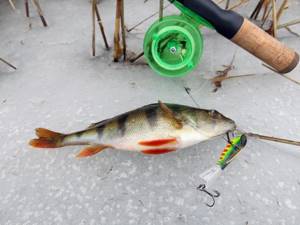
Tail design
Non-standard solutions are used in almost every part of such balancers. The tail of the winter bait is noticeably narrowed, but then it gradually widens. There is a small characteristic bend at the end of the caudal fin.
This feature makes the wiring really similar to the movement of live fish , significantly increasing the likelihood of bites.
Color
Almost every model uses dark colors on the bait in the area of the simulated back - this is a distinctive feature of such balancers. The black color favorably emphasizes the shape of the case, making it more distinct and noticeable.
The main color of the tackle is a bright acid color. It is noticeable from afar even in muddy water.
But the belly of the bait is much more varied. Now there are 17 variants of different colors of this part of the pseudofish, which are used quite successfully.
Body
The company actively promotes teardrop-shaped balancers and wobblers . This gives the silicone structure maximum resemblance to a live fish and allows the bait to play naturally.
There is a peculiar small fin on the back, and this is not only a successful imitation. Such a fin stabilizes the fall of the bait into the water , making it attractive to predators in water bodies from the very beginning. Usually, after casting, many balancers twitch chaotically in the water for some time, this scares away the fisherman’s prey. In the balancers of Latvian manufacturers, this seemingly trifle is also excluded.
Hook location

It is curious that this manufacturer did not make hooks on its own, but decided to use products from the world leader in this field - the well-known company Owner.
But the location of the hooks has already been developed directly by Lucky John. On the Mebaru balancers, it was decided to place them on the caudal fin and on the front of the abdomen.
Expert opinion
Knipovich Nikolai Mikhailovich
Zoologist, hydrobiologist. I am interested in fishing at a professional level.
Important! The design does not have a nose hook. This makes it easier to play the bait and does not catch it on snags or any other obstacles.
At the same time, it is the tail part of the bait and the abdominal front part that are the most frequent attack areas that predatory fish use when attacking their prey.
Bait game
It has several options at the request of the fisherman . The bait has three holes at once, to which it can be attached, this makes it possible to play the game in different ways.
Sometimes even pike, which are sometimes passive in cold water, react weakly to the usual play of bait. Then a hole for attaching bait near the tail fin may come in handy. In this case, the bait makes movements reminiscent of the actions of a wounded fish. The predator can rush towards such prey with greater activity.
It has already been noted that the natural play of the bait begins as soon as it falls into the water, which significantly increases the likelihood of an aquatic predator attacking the balance beam.
Attractiveness of the bait
Mebaru from Lucky John has the appearance of a well-fed fry. For a fanged predator, as pike perch is also called, such bait is very tempting. In the cold season, a passive predator, in order to save energy, prefers larger prey and practically does not react to small baits.
The color scheme of Mebaru balancers plays a very important role in luring a predatory representative of the ichthyofauna onto a hook . The presence of at least four shades of balancer in each type of color allows the bait to closely resemble the natural prey of pike perch.
However, the main difference between Mebaru for pike perch and other types of bait seems to be its scallop. There are three holes on it that allow you to attach artificial live bait in different positions:
- In order for the balancer to deviate as much as possible from the hole in different directions, and a sweeping game is obtained, the Mebara is attached to the hole located closest to the head of the bait. This method of attachment makes it quite easy to lure active fish predators to the hole.
- Landing the Mebaru on the middle hole using a fastener causes the bait to draw a figure-eight trajectory underwater to attract pike perch. This balancer attachment ensures the most stable behavior of the bait. The balancer with this mounting is capable of describing a more sweeping figure eight than Rapala, Karismax and other models of similar baits from the manufacturer Lucky John.
- When a fanged predator is detected, if it does not react to Mebaru’s active behavior, the third bait option is used. Attached to a hole located on the comb near the tail, Mebaru ceases to behave stably when attacking pike perch. The bait does not describe the standard eights, but imitates the behavior of a small wounded fish that has no strength left to escape from its predatory pursuer. Such animation often provokes a passive fanged predator to attack or catches it from a hole if it only pushes the bait and does not get caught.
The presence of a fairly wide range of Mebaru balancers from Lucky John gives every winter fishing fan the opportunity to choose a color and choose a bait of the appropriate size and weight. Depending on the conditions and location of winter fishing, the fisherman can always choose the right bait from the Lucky John Mebaru balancers. Its strength will eliminate the need to constantly correct the balancers after violent attacks by pike perch.
Mebaru Pro Series 67 balancers from Lucky John are quite in demand among anglers. This model has many positive reviews from fans of winter fishing for pike perch from different regions and cities.
Pros and cons of such balancers
The advantages of the gear include:
- the presence of small winding rings makes it easy to change hooks if necessary;
- the absence of a front hook minimizes snagging of the tackle on the ice edge, which often leads to the unfortunate loss of almost caught fish;
- the integrity of the bait from a single material makes it especially strong; the tackle does not fall apart into separate components when captured.
Some fishermen include the following disadvantages:
- lack of a nose hook, sometimes the pike attacks the fish from this side;
- the absence of single hooks, this sometimes scares away small predators.
However, many fishing enthusiasts are hardly bothered by these circumstances; the product has much more advantages.
Mistakes when winter fishing for pike perch with a balance beam
Often, catching pike perch in winter with balance beams does not give results, even with a well-chosen bait and acquiring a number of skills in its use. The reasons for this may be poorly tied balancers, which are not capable of performing the necessary animation and can even come off without the participation of the fish itself. Before fishing, you need to check the sharpness of the hook.
Failure to match the fishing line with the required breaking load leads to loss of gear and the inability to pull out a large specimen. It is necessary to check the breaking maximum experimentally, since the description on the packaging can be misleading.
During the process, it is important to fish the hole in all layers, because the behavior of the fish is unpredictable and a bite may appear in the most unexpected place. Regardless of the technique and place for catching pike perch, the action should always begin with hitting the bait on the bottom, otherwise the fish will not pay attention even to the best animation.
When fishing, under no circumstances should you make sudden movements. The main thing in the process is patience and smooth wiring.
What kind of fish can you catch?
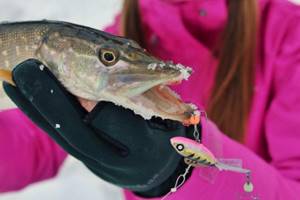
Fishermen identify the following types of fish that willingly attack balance beams of a similar design:
- the perch attacks very sharply and often if you come across its parking place, the sharpness of the bite indicates the obvious interest of this predator in this particular type of gear;
- The pike perch reacts faster than others to the appearance of such bait if it is nearby;
- Pike attack such small balancers quite well.
Much depends on the size of the bait; models are available in different sizes and colors.
Comparison with other models
There are several quite catchy lines of balancers, which in shape and behavior resemble the Mebaru line, but have differences, including negative ones.
| Balancer lines | Distinctive qualities | Noticeable Flaws |
| NILS MASTER NISA | Products from a Finnish manufacturer, well suited for shallow waters | Much higher in price, especially for pike |
| RAPALA | Provides good play, has sharp hooks | The design contains not only tees, but also single hooks, this increases the number of trips |
| DIXXON “Pike-perch” | Catcher for pike perch, inexpensive | The surface of the model is easily scratched |
| FROST NOVA | Affordable Russian balancer for perch | The tail part is poorly secured, the tee seems a bit small |
| KUUSAMO TASAPAINO X-PRO | Small, well-playing tackle | When attacked by pike, it is often lost due to its small size and fragility. |
Catching balancers for pike perch
What are the best balancers for pike perch in winter - the choice is extensive. Various manufacturers offer models that differ in game, shape, color and size. A distinctive feature of quality baits is their price - most cheap ones only take up space in a fishing box.
The main options for balancers used for catching fanged predators in winter:
- with a metal body and a plastic tail;
- with fur tails instead of wings;
- with a metal body coated with silicone;
- combined - wings and wool tail on one model.
Read also: The best winter lures for pike perch
Ideally, the color of the balancer matches the natural food items of pike perch in winter. In addition, the habitats of the “fanged” are taken into account:
- in well-lit places, dark-colored baits are used;
- Bright colors, luminescent colors and light accumulator areas are intended for dark, deep places.
Advice! The working depth of the balancers is determined by the weight and manufacturer's recommendations. The usual size of balancers used is 5 cm, for large specimens - from 7 cm, with the largest models used at the end and beginning of winter.
Attention! Copies of branded baits are cheaper, but no one guarantees their correct performance. In most cases, price determines quality.
How to choose the right one

By color
- many anglers note color No. 208: light burgundy with a dark spot on the back; other balancers do not have such colors, except for fakes; This tackle is especially catchy in muddy water;
- olive with yellow spots-dots under No. 302 works well; it is believed that such a balancer is especially good for December fishing;
- color No. 210 may seem inconspicuous - there is a yellow blot on the gray background of the body of the balancer, but, apparently, it attracts a predator;
- traditionally catching acid colors, of which No. 24 stands out, works great in turbid water;
- Most anglers consider tackle No. 15N to be the most catchy - silver sides, bluish back, and even with an orange dot on the head - this balancer simply cannot fail to be catchy.
To size
It all depends on what kind of fish you are going for:
- if you are going for medium-sized perch and small pike-perch, choose 37 mm tackle;
- for trophy perch and small pike, already take balancers measuring 47 and 57 mm;
- 67 mm – use where large specimens are present;
- and for captured specimens, take a size of 77 mm.
Top 5 best balancers for pike perch in winter
Despite the huge variety of models, there are also the best balancers for pike perch in winter that are most recognized by most anglers. These lures must be manufactured by the company that created the balancer.
Read also: Hunting for pike perch with a balance beam
The most catchy balancers for pike perch in winter are:
- Kuusamo Tasapaino 75;
- Rapala Jigging Rap;
- Nils Master Jigger;
- Lucky John Fin;
- Scorana Ice Mark 2.
Kuusamo Tasapaino 75
Length 7.5 cm, weight 18 g. Available in sizes 5 and 6 cm. Hard plastic tail. Imitation of scales. A sweeping game both in currents and in still water. There are no big differences in the game depending on the size. The bite often depends on the size of the balancer used. The bycatch often includes large perch, bass and pike.
Rapala Jigging Rap
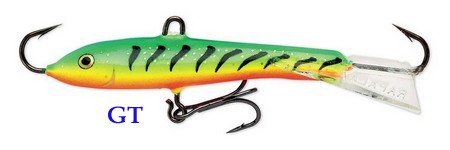
Produced in 6 sizes – W05 – 5 cm, 8.9 g; W07 – 7 cm, 14 g; W09 – 9 cm, 21 g; W11 – 11 cm, 32 g. There is a colored eye on the suspended tee, which additionally attracts pike perch. Works great in moments of low predator activity, simulating a sick fish. Great for catching active fish. Perfect balance and virtuosity of play. Works on both sharp and smooth strokes. The catchability of the bait is evidenced by its frequent use in competitions.
Nils Master Jigger
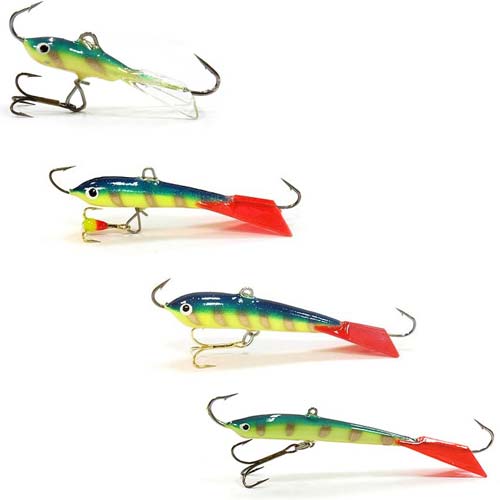
A range of 4 baits – Jigger 1 – 5 cm, 8 g; Jigger 2 – 7 cm, 15 g; Jigger 3 – 8 cm, 25 g; Jigger 4 – 12 cm, 45 g. The metal body is covered with a plastic shell. Long tee on the belly. Hand painting. Perfect balance. A specific “pike perch” game with a sharp departure to the side, a smooth turn and a sharp return. Suitable for fishing both in depths and shallows, both in currents and in still water. Shows best results at the beginning and end of winter. It works worse in the middle of winter.
Lucky John Fin

Extensive model range. Pike perch is caught with baits with a length of 5 cm. The 7 cm long version weighs 20 g. Thanks to its flat shape, it can cover a larger area than a classic balancer. Simulates a living fry. Feature: plastic tail. There is a bright colored bead on the tee. The coloring is specially designed to attract pike perch. Designed for winter fishing at depths of up to 20 m, but works in all water levels. Forgives mistakes in tackle handling skills.
Scorana Ice Mark 2
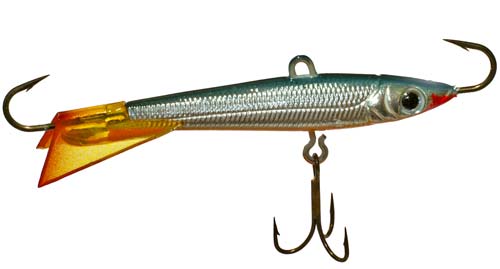
5 cm, 12 g; 6.5 cm, 21 g; 8 cm, 32 g. This tall-bodied balancer has large eyes and bright colors. The game is measured and powerful. The amplitude of the game is sweeping. The color is bright. Suitable for both bodies of water with and without current. Capable of twisting. When choosing a balancer, you need to take into account that even fishing with “branded” baits highly depends on the reservoir, fishing conditions and other objective and subjective factors.
The main purpose of balancers in winter is fishing during periods of activity. During periods when pike perch are passive, it is better to use natural baits.
The balancer is a horizontal spinner, so it has many wiring options, like any other spinner.
Read also: Catching fanged fish with sprat
TIPS FOR SELECTING A BALANCER AND FISHING TECHNIQUES
The main problems when fishing for pike perch in winter are tempting fish to bite and finding habitat. Often, even knowing clearly the location of the pike perch, fishermen are left without a catch.
Some tips for choosing bait and fishing techniques for pike perch in winter:
- for novice fishermen, universal balancers will be the best choice in winter; for experienced ones who want to catch trophy pike perch - large ones, for great depths;
- large and heavy baits are used at great depths, light and small ones at shallow depths;
- each bait is manufactured for a specific wiring, so it is necessary to take into account the manufacturer’s recommendations;
- during periods of activity of pike perch, the game of bait fades into the background;
- The game becomes important during periods when there is fish under the hole, but it does not bite;
- for variety of wiring, shortened and extended pauses and wiring are used;
- in the wilderness, the “jig” technique of retrieving is used, lowering to the bottom, slowly rising;
- More often, pike perch reacts to a balancer playing at a distance of about 30 cm from the bottom;
- in winter you need to constantly look for fish, experiment with baits and retrieves;
- hard cutting in winter completes any change in the balancer's game.
The more an angler masters different types of baits and retrieves, the greater his chances of catching. Only practice can answer all the questions about catching pike perch on a balance beam in winter.
Making balancers at home
Most fishermen who make homemade gear with their own hands make some kind of Mebaru balancer with two tees at the bottom and at the tail from a lead blank. But we are talking about silicone gear. So let's try using silicone. We select materials and tools:
- It’s better to have a donor balancer on hand;
- dilute gypsum in water and bring it to thicken;
- We separate the hooks from the donor workpiece;
- drown it halfway in plaster and wait for it to thicken;
- then fill the workpiece completely with plaster;
- before this we place loops of stainless steel wire at the tail and on the abdomen; tees will be attached to them;
- between both parts of the resulting blanks we leave a hole-groove for pouring silicone;
- We take out a sample balancer from the plaster molds;
- Lubricate the molds with grease, fill them with molten silicone, let them cool.
We remove the forms, the tackle is ready. All that remains is to make three holes in the upper fin for mounting options for the bait, paint and attach tee hooks.
You can buy silicone material in a store or use old silicone baits, which can be easily melted, for example, in the microwave and molded into the desired shape.
Alternative models
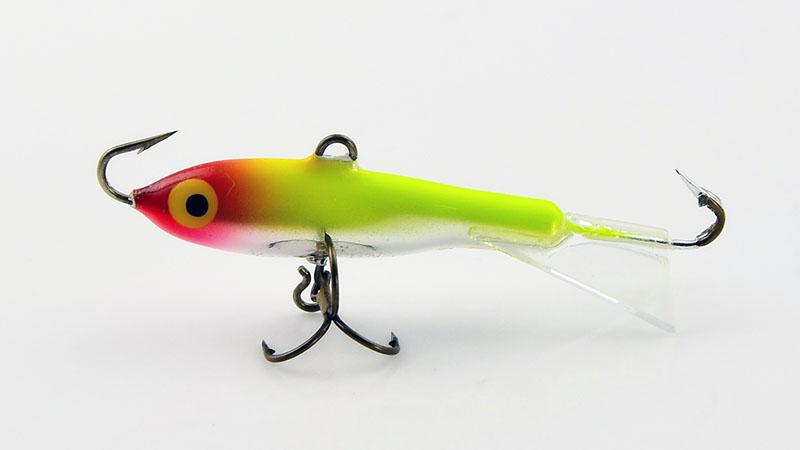
We have already described some of them in the table. It should be mentioned that there are supposedly quite good copies on sale. But they are unlikely to fully repeat the game of the original, and the quality of their material is clearly not higher. You can also mention models with tees:
- Nils Master Jigger-2;
- Aqua Jig-2 Trapper;
- Nils Master Nisa 50.
However, they all have a front single hook that encourages snags, and only one hole for attaching gear.
